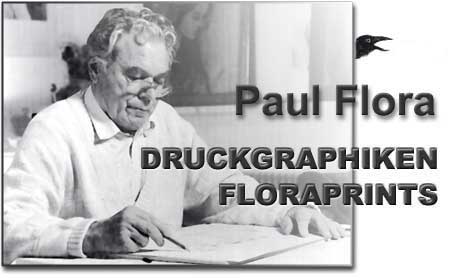Flora, Paul,
AUSTRIA Draftsman and graphic artist,
29.6.1922 Glurns/South Tyrol, 1927 moved to Italy. to North Tyrol, Stud. in Munich 1942-44 with Schinnerer and Gulbransson, 1944/1945 soldier.
From 1945 he worked as a freelance artist in Innsbruck. Visits Alfred Kubin in Zwickledt/Upper Austria, begins an art career. fruitful friendship until Kubin’s death. First solo exhibition 1945 in Bern, first own book 1947.
In the early days, many book illustrations of satirical content. 1948 member of the Art-Club/Vienna, from 1953 collaboration with Diogenes-Verlag/Zurich, between 1957 and 1971 weekly drawings in the Hamburg newspaper “Die Zeit”.
Collaboration with international newspapers such as “The Times Literary Supplement”, “Du”, “Dagens Nyheter”, “Observer”. From 1964 to 1992 he curated exhibitions for the municipal Taxis Gallery in Innsbruck.
Awards (selection):
- Prize of the Tyrolean Government 1948.
- Prize of the Society for the Promotion of New Art, Vienna 1948.
- Badge of Honor of the Province of Tyrol 1959, honorary locomotive engineer of the Zillertal Railway since 1964,
- Great German Federal Cross of Merit 1985,
- Corresp. Member of the Bavarian Academy of Fine Arts since 1986,
- Premio internazionale Asiago d`Arte Filatelica 1986,
- Honorary citizen of the town of Glurns 1992,
- E.O.Plauen Prize, Chemnitz 1999,
- Honorary citizen of the city of Innsbruck 2002
The genial early work is initially strongly influenced by Kubin. Even before 1950, he radically broke with dense hatching and turned to fine-nerved, thin-lined, delicate outline drawing. He consistently developed an unmistakable stroke technique with ink pen, which is identified with far beyond Europe.
The techn. Mastery is joined by an eye for the original, sometimes offbeat subject. The wit ranges from caustic satire to mild irony to serene humor. Even when he made caricatures, Flora always saw himself as a draftsman.
Recurring themes are cities like Venice with its carnival and commedia dell’arte, acrobats, autumn moods, military scenes, arrogant arrogance of the rulers as well as the organized bourgeoisie of clubs and associations, erotic and other misfortunes, downfall scenarios of the imperial and royal monarchy as well as Richard Wagner, Napoleon, Nietzsche, Edgar Allen Poe. Heraldic animal and at the same time frequent motif is the raven.
In the sixties, the stroke becomes firmer, the outline thicker, the internal drawing visibly dominant. Beginning in the 1970s, hatching began to reclaim the page in a distinctive way, creating powerful effects with the finely graded contrast of light to dark. At the same time he also used color sparingly as another painterly element of his drawing work (watercolor, later colored pencil). In the eighties he adds pencil drawing to his ouevre.
Finally, in his later work, a strong lyrical element appears in some of the paintings: autumn landscapes, lonely riders in the fog, bare trees, lonely decaying houses. Flora’s graphic impressiveness was groundbreaking for the 20th century and he left his mark on it as a draftsman like no other, becoming not only one of the most important but also one of the most popular draftsmen in Europe. Works from his hand can be found in many public and private collections.
Exhibitions (selection):
Galleries: BERN, Zofingia 1945.
VIENNA, New Gallery 1947.
MUNICH, Gurlitt Gallery 1949 and after
in many hundreds of galleries in Europe and the USA.
Regular galleries are: Innsbruck (Gallery Flora) and Salzburg (Gallery Seywald)
Museums: (selection)
MUSEUM FERDINANDEUM, Innsbruck 1952
Start of a traveling exhibition among others in: FOLKWANG MUSEUM, Essen; KUNSTHALLE BREMEN; WILHELM BUSCH-MUSEUM, Hannover; AARGAUER KUNSTHAUS; KUNSTMUSEUM WINTERTHUR; MUSEE DE GRENOBLE; MUSEUM NYMWEGEN; BIENNALE VENICE
ART GALLERY BREMEN 1959
WILHELM BUSCH MUSEUM HANOVER 1963
VENICE BIENNIAL 1966
SUERMONT MUSEUM AACHEN 1972
FOLKWANG MUSEUM ESSEN 1974
MUSEUM NYMWEGEN 1979
MUSEUM OF ARTS AND CRAFTS HAMBURG 1984
ALBRECHT DÜRER HOUSE NUREMBERG 1989
HISTORICAL MUSEUM OF THE CITY OF VIENNA (Retrospective) 1992
BAVARIAN ACADEMY OF BEAUTY ARTS (Retrospective) 1997
PALAIS ESPLANADE MERAN (Retrospective) 2002
PALAIS HARRACH Vienna (Retrospective) 2002
Books by Paul Flora:
Man thinks, 1947;
Mr. Huber in the wild west, 1947;
Flora’s Fauna, 1953;
The Musesross, 1955;
The warhorse 1957;
Mourning flora, 1958;
Vivat Vamp, 1959;
The ravages of time, 1961;
Oh my goodness, 1961;
King’s Dramas, 1966;
Vedute and figures, 1968;
The educated garden gnome, 1969;
The rooted Tyroleans and their evil enemies, 1970;
When the grandfather shot the grandmother, 1971;
Hungerburger Elegies, 1975;
Penthouse, 1977;
The pale bosom friend, 1979;
Futile words, 1981;
Nocturnos, 1982;
The Ravens of San Marco, 1985;
The withered splendor, 1990;
Early drawings, 1992;
Drawings (Retrosp. z. 75.Geb.)
Paul Flora und Karl Markus Gauß, Ein Florilegium, 2002 (z. 80. Geb.);
Paul Flora and Karl Markus Gauss, The Strange City, 2003;
Lyrics by Paul Flora:
Drawn and written, 1987
This and that, 1997
Articles among others in: C. Pack, Mod. Graphics in Austria, Hn 1969
Fox, painter (20.c.) I
1985 Wilhelm Busch Museum, Paul Flora, 1984
Bay. Acad. D. fine arts, Flora’s fauna, 1997
Kunsthistorisches Museum Vienna, Drawings 1938-2001, 2002 (z. 80. Geb.)
Movies about and with Flora
(between 1989 and 1993): The Ravens of San Marco. – Flora’s Fauna. – A fisherman in the Drüben. (On Alfred Kubin) – An Adventurer in a Dressing G own (On Paul von Rittinger).
In 1963 Flora designed stage sets, between 1985 and 1998 several series of stamps for Austria and the Principality of Liechtenstein. (among others 1988 Summer and Winter Olympics)
Source: Lexikon Thieme-Becker; Article: Karl Markus Gauss

